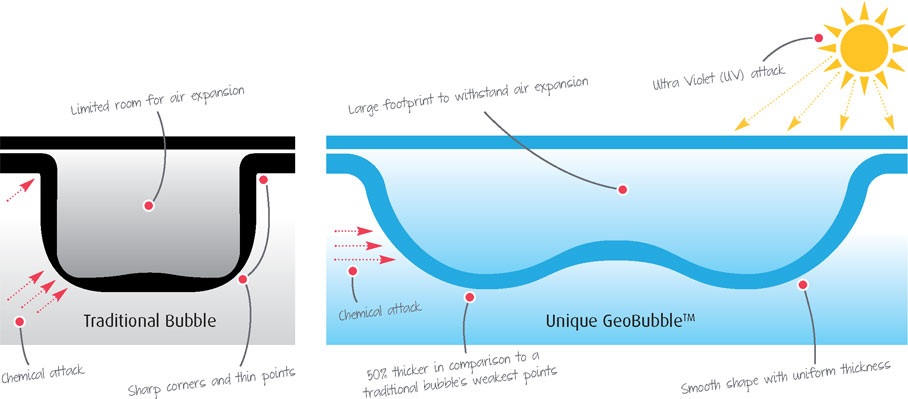How do you choose a good swimming pool cover? Here is some information to help you choose.
Heat is lost from a swimming pool by evaporation of the water surface, if you cover the water surface you will cut heat losses. A simple plastic sheet would do the job but it would sink so you need a sheet with bubbles to keep it afloat. The first pool covers were developed from the same technology as bubble wrap. The pool covers are made from two layers of plastic one flat layer on top bonded to a bottom layer with air bubbles in it. Pool covers are often referred to as bubble covers. The first pool covers were coloured blue because it seemed a sensible colour to choose.
Research on pool covers soon discovered that not only did they keep the heat in the pool by stopping evaporation but by a “greenhouse” effect they could also heat the surface of the water. This lead to the covers being refered to as Solar Covers. It was then discovered that if you made the bottom, bubble, layer of the cover in silver plastic then the silver reflected the heat back in to the pool like silver foil on a roast joint. Because of the blue top and the silver underside they are mostly known as blue/silver covers.
Thickness matters
Another consideration is the thickness of the plastic that the layers are made from. The thickness of the plastic is measured in microns. One micron is 1,000th of a milimetre. Some cheap covers are 100 or 200 microns thick but the standard thickness for our covers is 400 microns or 0.4mm. So our standard cover is made from 400 micron material with a blue top layer and sliver bottom layer and is refered to as a “400 micron blue/sliver”.
The next level up in quality is a cover made from 500 micron thick plastic. 500 micron covers come with a blue top layer and a gold bottom layer. Hence they are refered to as a “500 micron blue/gold“. The thicker material means these covers are harder wearing and they are heavier too. They do not retain much more heat than the 400 micron blue/silver but they do have a longer warranty. If you have a big pool the extra weight, 25% more, of this cover may be an important consideration for you.
New bubble technology
Pool Cover made using bubble wrap technology had some inherent problems. The corners of the bubble were thinner than the rest of the bubble and this weak spot was often the first point of failure. These tradition bubbles have been replaced by the new GeoBubble technology. The Geobubble has a bigger, double bubble with no inherent weak spots. This makes the GeoBubble cover the best type to choose from.
GeoBubble covers come in 400, 500 and 600 micron thicknesses and the colours are Blue/Silver, clear and black. The thicker the cover the longer they last but the cost increases as the thickness goes up.
And the winner is…
For a pool that is heated the blue/silver covers are the best for a combination of solar gain in the day and heat retention at night. So the best pool cover for general usage is the 600 micron blue/silver geobubble cover.
However the clear cover, known as the sol+ guard, should be considered if you don’t heat your pool and want to get the best from the solar gain.
The black cover is great for keeping sunlight away from the pool water so it will stop algae growth in the water. With a black cover on the pool you should not need to put winterising chemicals in the pool water.

